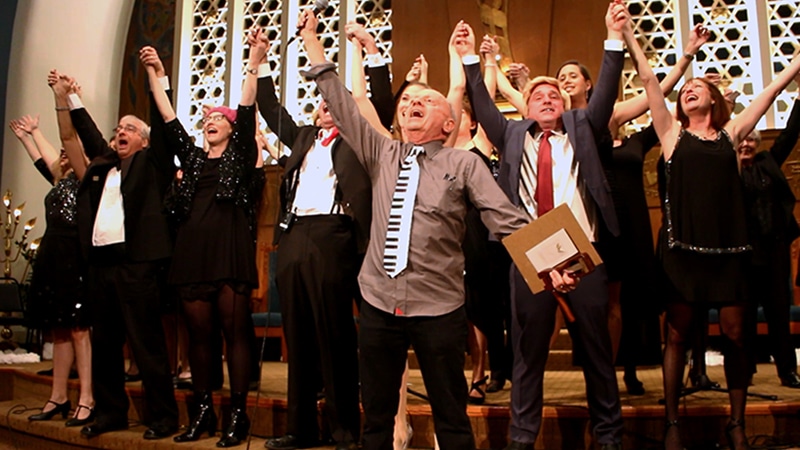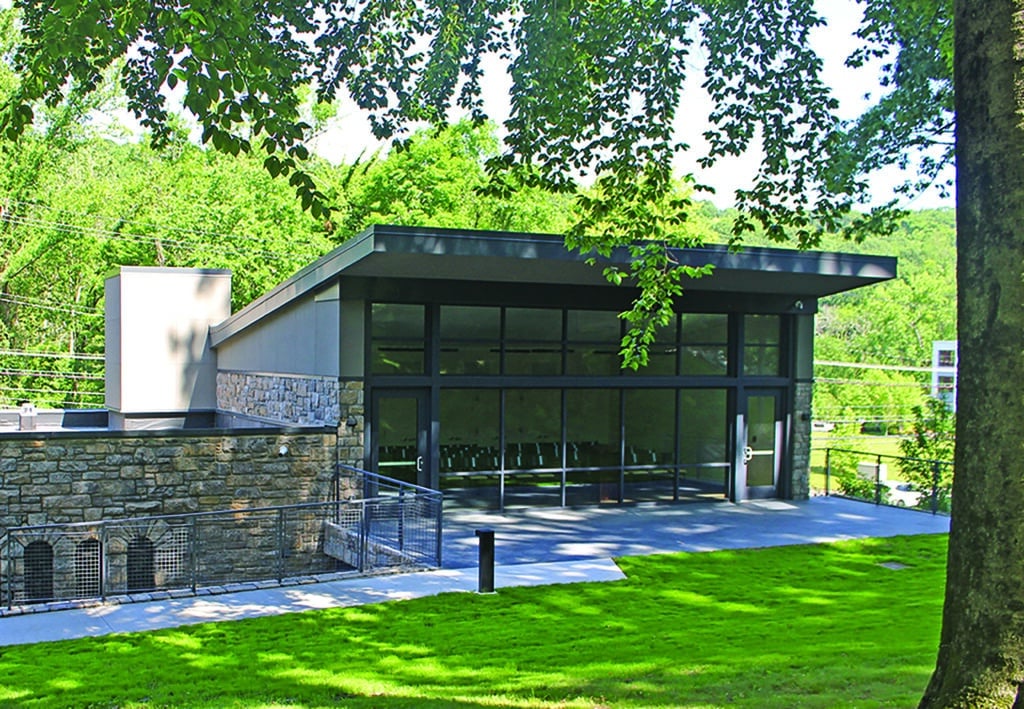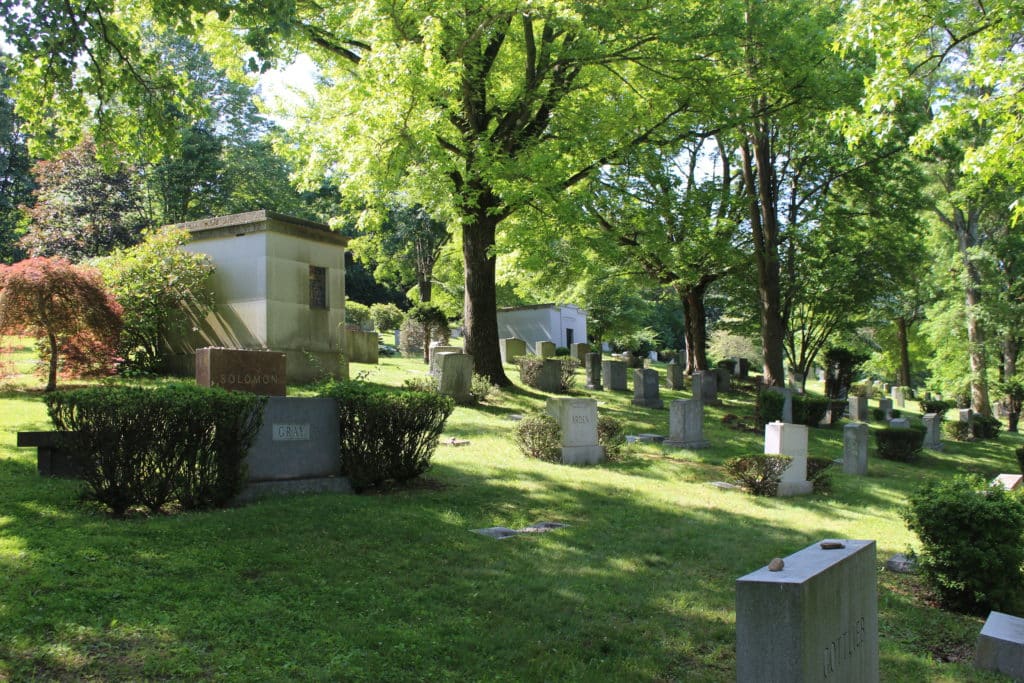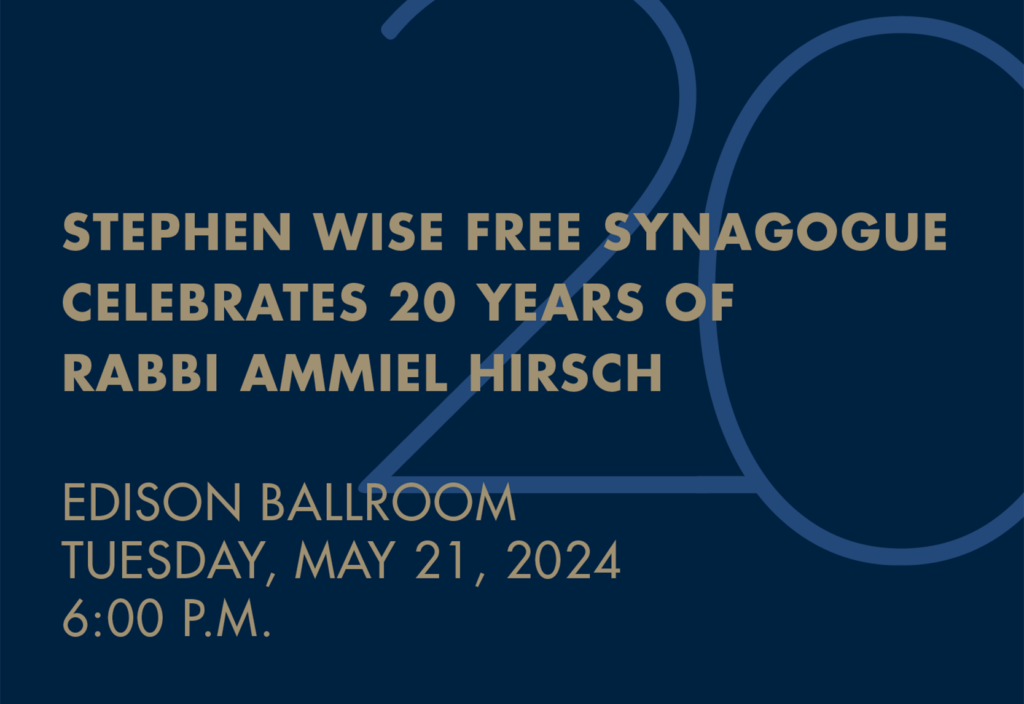Dear congregants, members of the Jewish community and friends:
Today is a day that will live in infamy.
On this Shabbat and Simchat Torah, the most joyous of Jewish festivals, Hamas launched an inhuman, brutal attack on Israeli civilians.
Thousands of rockets have been fired indiscriminately. Even worse, terrorists infiltrated Israeli towns, villages and kibbutzim, and gunned down men, women, children and babies.
There are reports of Israeli hostages, elderly women and infants among them, who have been kidnapped and taken to Gaza.
The number of Israelis killed and wounded is likely to be in the thousands.
I pray that Hezbollah does not join Hamas. In that event, there will be a full-scale regional war.
The days to come will be filled with pain and sorrow. Israel will prevail, but many will lose
their lives, and many others will be maimed and scarred for life.
The attack came a day after the 50th anniversary of the Yom Kippur War and, like then, it appears that Israel was taken by surprise. Like then, the aftermath of these days will be seared in our consciousness.
There will be a time for investigating what went wrong. For now, we pray for the souls of the dead and the full recovery of the wounded. We call on the international community to condemn in the strongest terms the war crimes committed against Israelis. We pray for the well-being of the soldiers of the Israel Defense Forces as they seek to bring Hamas terrorists to justice and ensure the safety of Israeli civilians.
May God comfort Zion. May gladness and joy, thanksgiving and the sound of music return quickly to the cities of Israel and the streets of Jerusalem.
Rabbi Ammiel Hirsch
Stephen Wise strongly recommends that all people follow the CDC’s COVID-19 prevention guidelines, including staying up to date with COVID-19 vaccines and boosters.
The synagogue is no longer checking vaccination status upon entry.
Mask-wearing is optional for anyone entering our building. Anyone who prefers to wear a mask in our building is encouraged to do so. The synagogue has surgical masks available for congregants at the entrance and we have set aside a special section in our sanctuary for people who want to wear masks during services and prefer to sit apart from those not wearing masks.
Members and guests are encouraged to stay home when they do not feel well or if they are exhibiting any signs or symptoms of COVID-19.
(This policy was last updated on January 20, 2023.)
“This is the closest I’ll get to being on Broadway,” says Eileen Remor of our annual Purim spiel — the musical parody play that commemorates the salvation of the ancient Jews of Persia from slaughter at the hands of Haman. A longtime Stephen Wise member with experience in event and TV production, this will be Eileen’s 14th time singing and dancing in one of our spiels — and her first as production manager.
“We have a group of extremely dedicated Purim spielers who come back year after year to put on the most amazing shows,” says Rabbi Sam Natov, who oversees our Purim programming. “Two of my most burning needs in life are self-expression and being a part of a community,” Eileen explains. “Both are met through my role as a ‘Purim Spieler.’”
One particularly dedicated congregant wrote our Purim plays for 29 years. Before finally retiring in 2017, Norman Roth told The New York Times: “I heard the applause and I knew I had something, and ever since then, they’ve never let me stop.”

“Norman was a spiel-writing machine, and his amazing scripts are still sought after by synagogues around the world,” says Cantor Dan Singer, who has big shoes to fill as our new playwright. Cantor Singer finds that once he’s decided on the music and storyline, “the ideas flow quite quickly from there. I can finish writing a full Purim spiel in just a week or two, but then the editing process begins and that takes longer.”
Cantor Singer chose to parody “A Chorus Line” as a tribute to Gerald Schoenfeld, who helped bring the show to Broadway and is credited with saving commercial theater: “I felt that show has the most relevance to our present situation.” Giving us a preview, Cantor Singer explains: in “Api-Chorus Line: A Chorus Spiel” (a play on “apikoros,” Hebrew for “heretic”), King Ahasuerus plans to reopen Shushan Palace and resume Broadway shows despite a global pandemic. As the king’s casting director Haman searches for the best actors and singers in Shushan, he also plans to use auditions to find the city’s Jews — and execute them! How can Esther and the kids save Shushan from Haman’s awful show?
“This year’s spiel is a little different,” says Rabbi Natov. “Because of pandemic restrictions and all the uncertainty, we decided to pre-record it.”
On March 16, we’ll be gathering in our sanctuary for the Megillah reading at 5 p.m. followed by a children’s costume parade and dance party at 6 p.m. Then head home or to your nearest internet-enabled device for our spiel’s premiere at 7 p.m. — available virtually exclusively available virtually exclusively on our website and on Facebook and YouTube (or join our Zoom watch party)!
“Since the synagogue is a block away from Broadway,” Eileen asks: “can we call it off-Broadway?”
The importance of values-based early childhood education has never been more apparent. Watching the news, I can’t help but think that if people had a foundation rooted in caring for others, the ability to think for oneself, and understanding of the importance of community, they wouldn’t behave in the disheartening ways we see today.
I believe that quality early childhood education begins with core beliefs about children. We must see children as capable citizens of the world who can construct knowledge, rather than as vessels to be filled by known facts. We must help them develop a sense of how we as people are interconnected and must rely on and care for one another. And we must model respect and kindness for them in all our interactions. When educators hold these core beliefs at the center of their work, all of their choices are made with love and intention.
Young children are just beginning to form their understanding of themselves as individuals and their approach to the world around them. They are building the fundamental tools for creating relationships. We have an amazing opportunity to influence their approach and feelings about themselves and others. So, how do we do this?
First and foremost, we can relate with children in partnership. If we believe that they are capable of constructing knowledge, we want to provide open-ended experiences for them to explore. Rather than entering the classroom with an agenda of what to teach them, we can intentionally provide materials and experiences that allow children to explore and develop theories. This begins with the materials we make available. From prisms in the windows, to magnifying glasses, to blocks and loose parts, materials can encourage children to create and explore rather than perform a specific task.
This does not mean leaving children to their own devices; teachers are paying close attention to what the children do and say. They engage with the children in their wonder and excitement, and challenge them to explore theories and experiment with materials and ideas. For example, when children notice rainbows on the floor, we encourage them to wonder, “Where did the rainbows come from? Are they changing? How can we interact with them?” In this way, we are not telling children about the world around them. Instead, we are challenging them to think for themselves and showing them that their thoughts and ideas are valued.
Modeling the importance of community and respect for others is another essential lesson that we can foster in classrooms for young children. The way teachers interact with each other, with parents, and with the children send strong messages about the kind of society we value. Teachers play an important role as they balance the role of nurturer with the ability to challenge children appropriately. Children need to feel love and security from their grown-ups—this is essential—but they also must feel that their trusted adults have faith in their abilities. Teachers consistently send this message when they encourage children to try new things and to persist in something challenging, and when they celebrate successes along with children.
Teachers demonstrate the value in interconnectivity when they urge children to ask each other for assistance with something difficult, when they highlight the ways each child cares for the classroom and materials, and when they encourage children to help one another by saying, “She’s feeling upset. How can we help her?” When an issue or conflict comes up in a classroom, instead of the teacher determining the solution, she or he can bring the issue to the group and together discuss how to handle it.
For example, in one classroom, children may be constantly arguing over the use of a particular material. The teacher can choose to highlight this struggle and bring it up to the group. “I notice that everyone wants to use this toy and it leads to friends arguing and getting upset. How can we figure this out?” In doing this, the teacher is sending several messages to the children. She is telling them that she thinks they are capable of handling a tough situation and coming up with a solution. She is showing them that when conflict arises, we need to address it, and the group as a whole needs to devise a solution that works for all. If only these messages from an early childhood classroom could spread across the world.
I watched the principles outlined above come to life recently, through a year-long project taken up by one of our 4/5s classes. It started in the fall, when the children created a lemonade stand and raised money to buy items for the Next Step Men’s Shelter, which was housed in our synagogue. The children wanted to repeat the experience, and the teachers challenged them to think of a different means of raising money while still honoring their entrepreneurial spirits. Around the same time, teachers who had attended a weaving workshop for educators were inspired to bring the craft back to our classrooms.
Soon after, a pencil holder posted on the board outside of their classroom broke, and the children in this 4/5s class decided to create a new one. The first version, made of paper and tape, did not last long. One child decided to use her newfound weaving skills to create one. The success of the woven pencil holder led other children to become interested in weaving. The children then realized that their woven crafts were beautiful and unique, and they came up with the idea of selling them.
They decided to weave challah covers and sell those along with challah rolls that they would bake. The teachers led them to research challah covers, and students consulted with a Rabbi, and took measurements from challah covers borrowed from other classrooms. They realized that it would take a long time to create enough covers to sell, so they outsourced some of the labor—parents, grandparents, siblings, and caregivers were invited into the studio to learn how to weave and create challah covers. The children created instructions for their helpers to follow, with drawings and words to guide them. The children also created a company name, logo, and slogan. They became Super Weavers: Superheroes Who Weave Fast.
On the day of the big sale, the students quickly sold all their challah covers and rolls, raising more than $500 for the men’s shelter. One parent shared her thoughts on the project: “Hats/challah covers off to you for creating a space for the children to become social justice entrepreneurs, with a creative flair. The children seemed so proud of all they accomplished. Thank you for giving them this experience and the scaffolding of the curriculum to lead up to this all year. You’ve instilled gifts they will hold onto for a lifetime.”
This project exemplifies the impact of values-based teaching. The children were empowered to solve problems, research, and take ownership over their ideas. The goal of raising money for the shelter speaks to their feelings of responsibility toward others. The way the children taught the community how to weave and invited all to their big sale is a wonderful example of the community participation and responsibility that these children see as a vital part of their school experience. This is just one example to illustrate the effects that values-based teaching can have: children who feel emboldened to create and to care for their community.
Miriam Kalmar is director of the Early Childhood Center at Stephen Wise Free Synagogue in Manhattan.
This article originally appeared in the 2022 Parents League Review and is reprinted with permission.
“Tzedakah Project: Tzedek, Tzedek Tirdof,” you’ll see on a sign greeting you as you walk into our synagogue.
“It’s part of a new initiative by our Religious School to teach our students about the concept of tzedakah, which means righteousness,” explains Rabbi Rena Rifkin. “We want to connect our students with people who are doing the work of tzedekah, and also be thoughtful about where we donate.”
“Tzedek, Tzedek Tirdof” — “Justice, justice shall you pursue,” God tells Moses and the Israelites in Deuteronomy 16:20, commanding them to create a fair legal system and government. “The Jewish value of tzedek often gets lost in the concept of tzedakah,” says Rabbi Rifkin. “We often think of tzedakah as simple charity, but it’s really a much deeper mitzvah — about justice, equity and equality.”
And so, as part of its curriculum, the Religious School seeks to differentiate between charity and justice. “The concept of tzedek represents more intentionality than just the act of charity. Through this project, we hope to help our students be more thoughtful about where and how they want to give their time, money and energy,” says our Religious School’s assistant director, Julia Bennett, “and for them to bring acts of tzedek into their daily lives.”
“It’s so important for young people to feel empowered to change the world,” says Social Justice Program Associate Steven Morris. “We’re teaching our students to learn how to translate Jewish values into social action.”
Sitting on the tzedakah table behind the sign are five plastic jars, each slowly filling up with money earmarked for an organization whose mission encapsulates a core Jewish value. Throughout this school year, our Religious School students of all ages are learning about these five different organizations and Jewish “tzedek heroes” from the past or present who represent each organization’s justice-related cause. For example, tzedek hero Justice Ruth Bader Ginsburg z’’l represents the National Women’s Law Center, which fights for gender justice, including equal pay for women.
“Our seventh graders have done tzedakah projects before, but this is the first time we’ve involved the whole school,” says Rabbi Rifkin. “It’s important for our students to see the different ways that Jews have engaged in the work of tzedakah and tzedek. To be able to relate to some of our heroes, understand the scope of their work — and to see that it’s not just about dropping coins into jars, but about working toward a more just world.”
The five organizations our students chose are: the National Women’s Law Center; HIAS, which is guided by Jewish history and provides vital services for immigrants and refugees; Jewish Youth Climate Movement, a Gen Z-led movement dedicated to fighting climate change through a Jewish lens; The Trevor Project, which seeks to prevent suicide among LGBTQ youth; and the Anti-Defamation League, which fights hate and antisemitism.
Gershwin, Guggenheim, and of course, our synagogue’s founder and namesake: Rabbi Stephen S. Wise. These are some of the giants on whose shoulders we stand and who are now at rest at our Westchester Hills Cemetery. Among them lies a lesser known, but equally noteworthy man: Sidney Hillman. A true Jewish leader, he helped shape our country — but he died 75 years ago. In fact, the deed to Hillman’s towering stone mausoleum is owned by the labor union he championed. “The memory of the righteous is a blessing,” says the Book of Proverbs. It’s up to us to keep his memory alive.
Born in a Lithuanian shtetl in 1887, Hillman founded the Amalgamated Clothing Workers of America, a predecessor of Workers United. By the age of 13, Hillman had memorized much of the Talmud and was on the path toward becoming a rabbi, but the universe had other plans. While attending yeshiva, Hillman immersed himself in the revolutionary fervor sweeping Russia. Arrested twice for political activity, he spent several months in Czarist prisons before immigrating to Chicago, where he endured brutal conditions as a factory worker. When 45,000 local garment workers went on strike in 1910, Hillman acted as their advocate, emerging as a leading spokesman and negotiating their settlement, thus beginning his rise as a labor leader and political organizer. “We want a better America, an America that will give its citizens, first of all, a higher and higher standard of living so that no child will cry for food in the midst of plenty,” he famously said.
Hillman’s gift to us is his legacy — one that Stephen Wise Free Synagogue works to preserve by feeding the hungry, housing the homeless, speaking up for the voiceless, and fighting for justice and equality. And to honor and sustain his memory — along with those of all who are buried at Westchester Hills — our community is committed to the cemetery’s upkeep and beautification. “The Everlasting is his heritage, and he shall rest peacefully upon his lying place,” we recite during Yizkor.
Our synagogue founded Westchester Hills Cemetery just north of the city in Hastings-on-Hudson in 1932 as final resting place for our community. Nearly a century later, it is just as beautiful as it was when it opened, but the infrastructure has needed a major repair. Now, thanks to more than $2 million in tzedekah from families whose departed loved ones are laid to rest there, and after years of planning, and a pandemic that temporarily paused all construction, we have renovated and repaired our stone chapel administration building, also known as the Gatehouse. The building now provides a comfortable setting for bereaved families with the addition of a visitor reception area, new bathrooms, and an elevator leading to a glass enclosed chapel. This tranquil room, which looks out on to the cemetery’s lush green hills, is a beautiful setting to gather your loved ones for memorials and unveilings. For the next phase of the restoration, we hope to repair the roads and drainage systems to make the site more accessible to you and your loved ones for years to come.
We invite you to visit Westchester Hills this fall and explore the stories that have shaped us. If you are interested in planning for the future, please contact Meredith Byrne at (914) 478-1767 or mbyrne@swfs.org.
Photos by Ryan Greiss.




